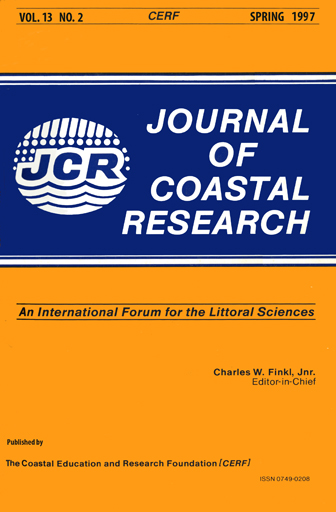Determining Sand Volumes and Bathymetric Change on an Ebb-Tidal Delta
Keywords:
Bathymetry, soundings, digital-terrain model, tidal inlet, ebb-tidal deltaAbstract
The bathymetry on and around an ebb-tidal delta at a natural headland and barrier-bound inlet on the Bay of Plenty coast, New Zealand, was surveyed using a modern, integrated echo-sounding and navigation system. The survey aims were to define the morphology of the ebb delta and nearby inner shelf, shoreface and beach and to assess the accuracy of the survey method for determining changes in bed levels and sand-storage volumes on the ebb delta. Alternate cross-shore track-lines, spaced at 100 m intervals on a box-grid measuring 2.2 by 4.4 km, were surveyed on two consecutive days; the duplicate bathymetry datasets so obtained were used to assess and survey repeatability and accuracy. Rectangular-grid, digital-terrain models were fitted to these bathymetry datasets. A triangulation surface fitting method was adopted, although examination of volume calculations and residuals statistics showed that there was little difference between this and methods such as kriging and inverse-distance weighting. The duplicate surveys showed that the accuracy of the surface-fitting and determinations of mean surface levels varied depending on the local seabed topography. On the shoreface and inner shelf, where the topography varied broadly, the mean bed-level uncertainty was only ± 4 mm, while on the ebb-delta platform with its high-relief channels and bars the uncertainty was ± 54 mm. The higher error over the ebb delta resulted mainly from the track spacing; errors due to the gridfitting and volume calculations were trivial in comparison. These results meant that repeat surveys with the same track-line spacing could only be expected to detect net sand gains over the ebb delta system exceeding 160,000 m3. This uncertainty exceeds the annual net littoral drift at this location. A main conclusion is that to detect net sand gains or losses over an ebb delta such as the example studied, track-line spacings should be tailored to the topography with denser spacings over channels and bars. Reconnaissance surveys and/or aerial photographs should be used to plan such optimal trackline strategies. Duplicate surveys over representative morphologic zones are also recommended to confirm the survey accuracy and to test for systematic errors such as those due to the tidal correction.


